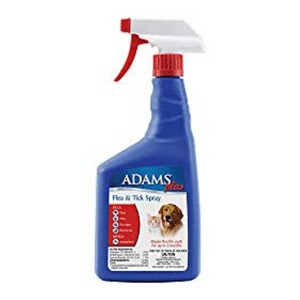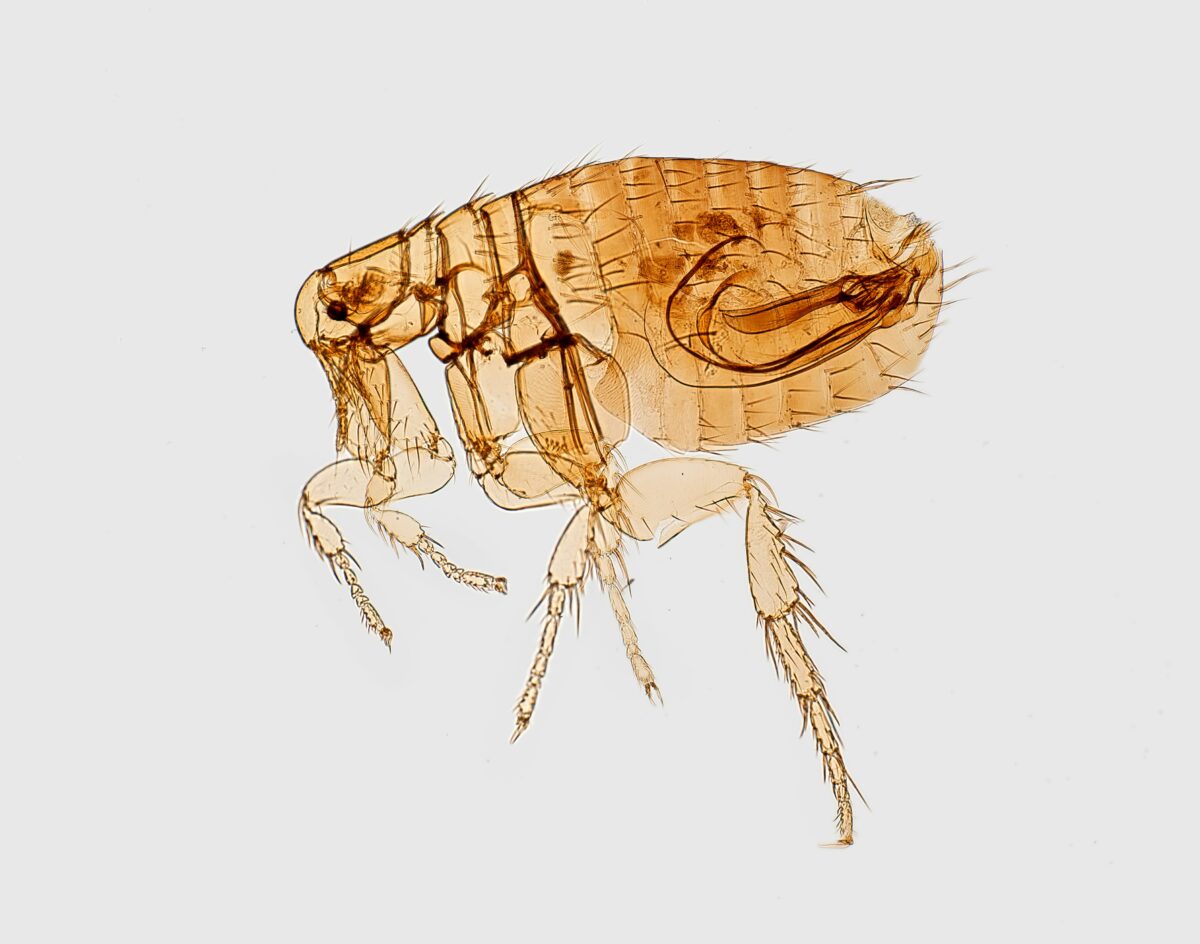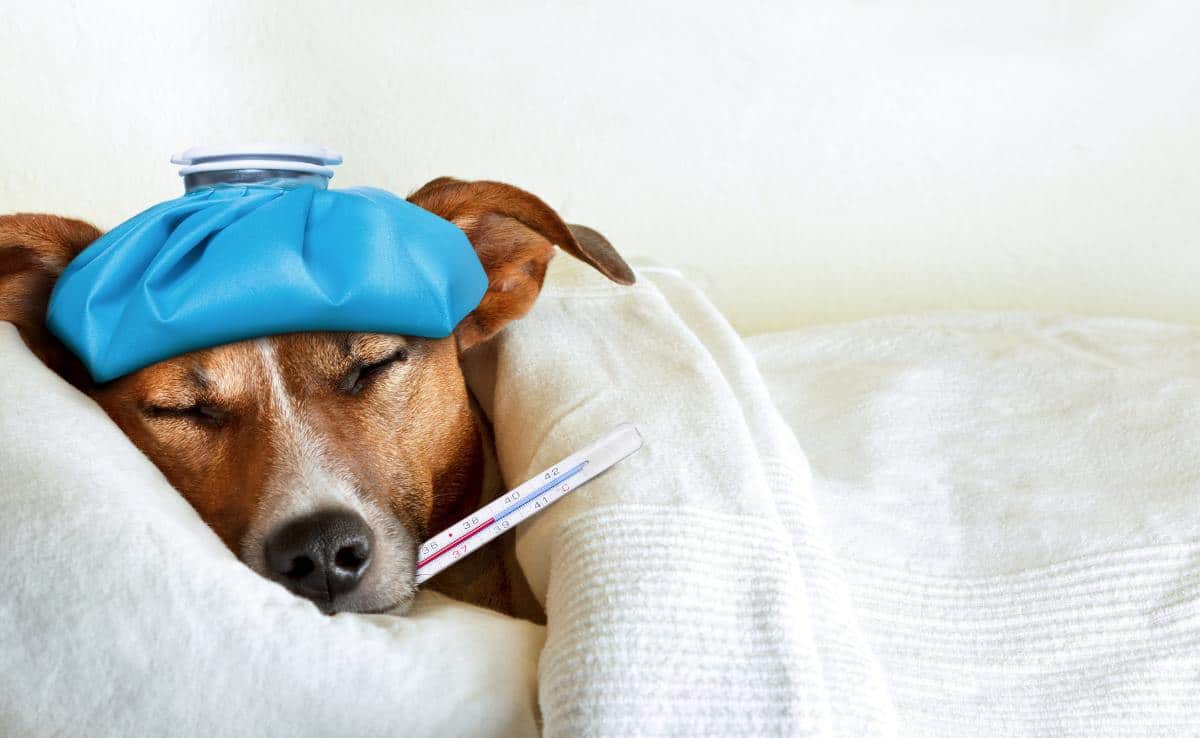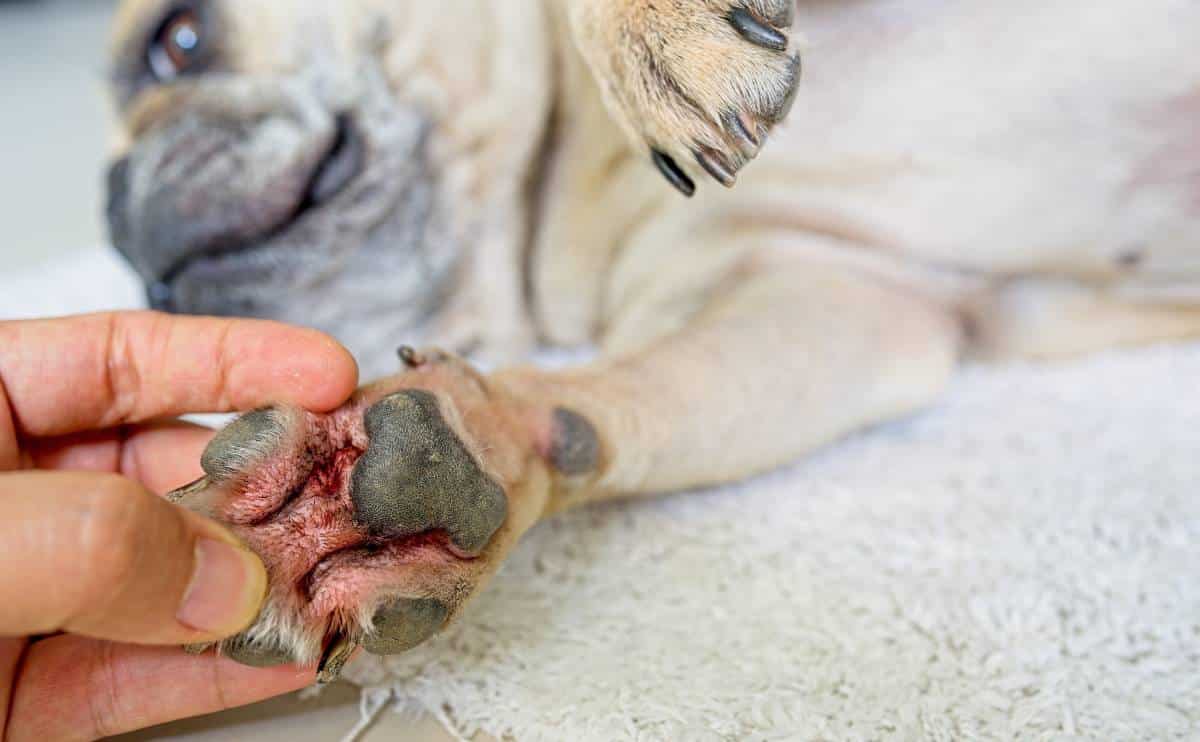Flea Eggs On Dogs Exposed: What They Look Like & How To Kill Them
When you purchase through links on our site, we may earn a commission. Here’s how it works.
Think you’ve beaten a flea infestation? If you haven’t tackled the flea eggs, you’re only halfway there.
Table of Contents
These nearly invisible pests are masters of hiding, woven into your dog’s fur, buried in your carpet, and tucked deep in furniture seams. And once they hatch? You’re right back to square one.
We’ve been there: fleas made our dog miserable, and it wasn’t until we spotted the eggs that we realized what we were really up against. Here’s everything we wish we knew before our dog suffered, so you don’t have to learn the hard way.
We’ll show you exactly how to identify and eliminate flea eggs, before they hatch and turn your home into ground zero for another outbreak.
What Do Flea Eggs Look Like On A Dog?
So, what do flea eggs look like to the human eye? Unfortunately, they’re difficult to spot, especially if your dog has light-colored fur. They’re only around 0.5 millimeters, about the size of a grain of salt or sand, off-white in color, and translucent.
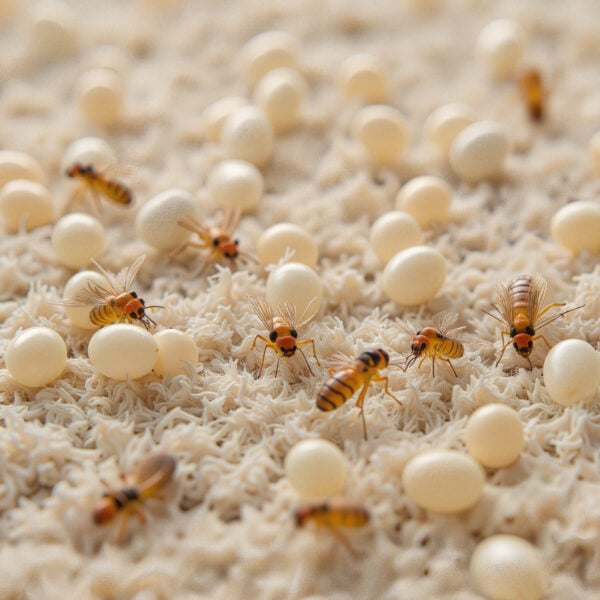
When inspecting your pup, it’s easy to confuse flea eggs for dandruff. The main difference is that flea eggs are oval-shaped rather than flat.
Flea eggs are:
- Oval-shaped and smooth
- Off-white to translucent
- About 0.5 millimeters in length (smaller than a grain of sand)
- Non-sticky, which means they fall off your pet and scatter across your home
Because eggs fall off their hosts easily, you may not see many on your pet. Still, you can use a flea comb to get eggs (as well as adult fleas and flea feces) off your pup.
The best way to tell the difference is to place the speck in question on a dark surface and inspect it using a magnifying glass. If it’s oval, then it’s likely a flea egg — especially if you’ve already found fleas on your pup.
Real-Life Flea Scare: Bella’s Beach House Infestation
Our yellow Lab, Bella, picked up fleas while staying at a beach house a few years back. We thought it was sand fleas at first, but then we saw the little white flea eggs and went directly to the pet store to get her treated ASAP.
Poor thing is also highly allergic to fleas, so she was miserable until we got it resolved, and her itchy, inflamed skin calmed down again. Luckily, it was our second-to-last day, so we left a day early, and the owners fumigated when we left!
– Michelle Schenker, Rescue Dog Mom & Canine Journal Co-Founder
Flea Bites: The First Clue You Have a Bigger Problem
If you or your pet are getting itchy red bumps, especially around the ankles, legs, or belly, it could be more than just a nuisance. Flea bites are often the first visible sign of a hidden infestation, and by the time you notice them, flea eggs and larvae are likely already embedded in your home. Don’t ignore the symptoms—bites often indicate a growing problem that requires immediate treatment.
You can see an example of flea bites on a dog in the image below.
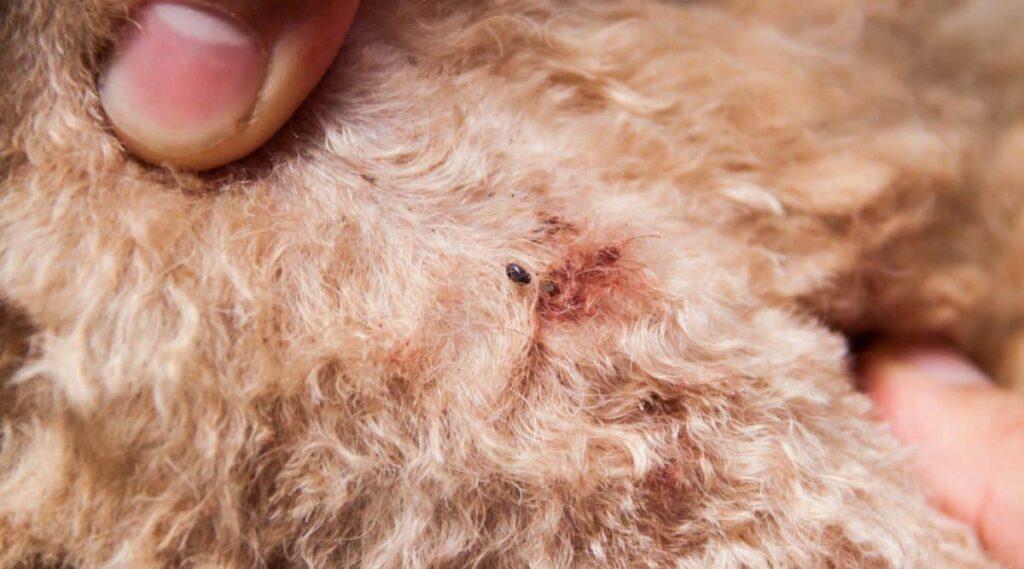
Flea Eggs vs Flea Dirt (Poop)
Many people also confuse flea poop, often called flea dirt, with flea eggs. Flea dirt is typically a bit larger than eggs, dark, and dry, resembling black pepper flakes.
If you put a few specks of suspected flea dirt on a white paper towel, add a few drops of water, and see a reddish color, then you can confirm that it’s indeed flea poop. You can find flea dirt on your pet, bedding, carpeting, furniture, etc.
What Do Flea Eggs Look Like in the Home?
Flea eggs are often mistaken for dust or dandruff, but don’t be fooled. These tiny white specks are the beginning of an infestation and can be found almost anywhere your pet rests, walks, or sleeps.
Because they’re so small and colorless, flea eggs can easily blend into carpet fibers, upholstery, or bedding seams.
What Do Flea Eggs Look Like On Furniture?
Although fleas lay their eggs in your pet’s fur, they don’t stay there: the eggs don’t stick well to your pup’s fur or skin, so they drop off easily. Of course, this means that they get on everything, including bedding, carpeting, furniture, between floorboards, and anywhere else your pup goes.
On furniture and elsewhere, they look like tiny specks of salt. You can confirm that they’re flea eggs using a magnifying glass (as mentioned above).
How Long Does It Take For Flea Eggs To Hatch?
Female fleas begin laying eggs within 36 to 48 hours of their first meal (their host’s blood). Within just a few days, one flea can lay as many as 20 to 50 eggs per day.
Depending on their environment, eggs can take anywhere from 36 hours to 10 days to hatch. They hatch faster in ideal conditions of higher heat and humidity.
Flea Life Cycle: From Egg to Infestation
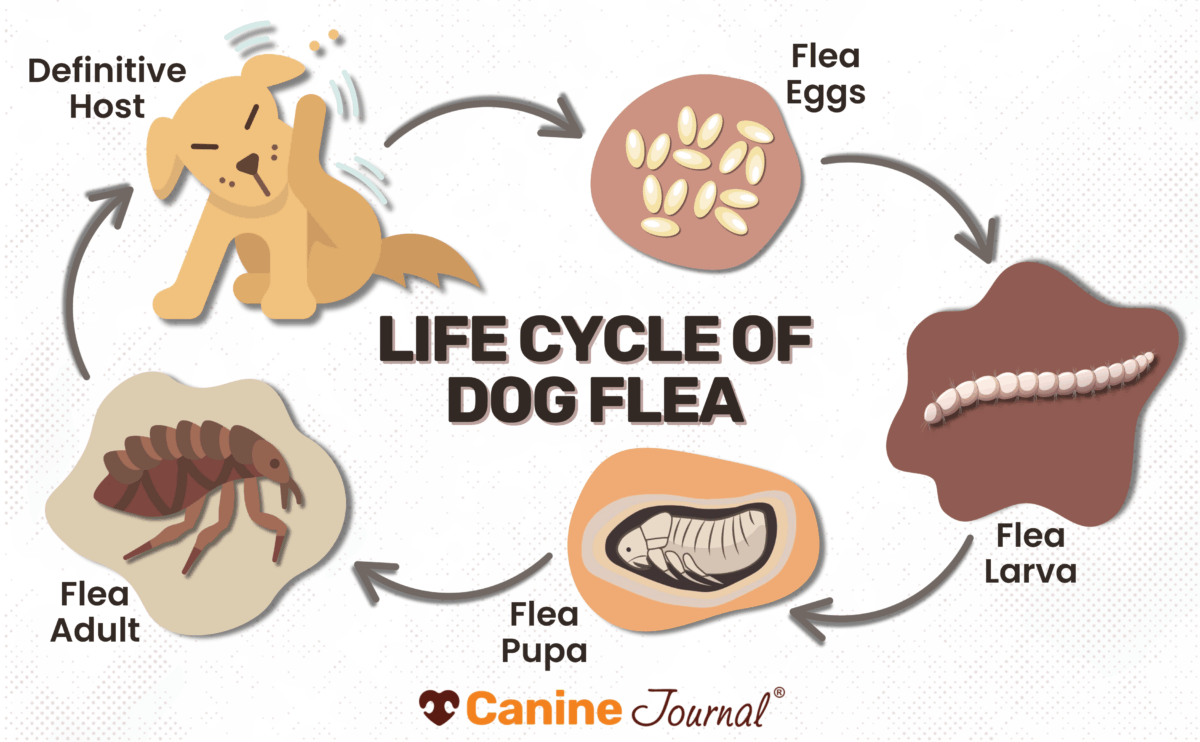
See the Flea Life Cycle in Action
Understanding the flea life cycle is key to breaking it. Eggs, larvae, pupae, and adults all play a role in ongoing infestations, and each stage needs targeted treatment. Watch the video below to see how fleas develop and why missing just one stage can lead to reinfestation.
What Do Flea Larvae Look Like?
Flea larvae that hatch from eggs look like tiny worms that are off-white in color and about two to five millimeters long. Within the next five to 14 days, they feed on flea dirt until they spin a cocoon and enter the pupa stage.
Adult fleas emerge from their cocoons anywhere from one week to several months or more — they don’t emerge until they detect body heat or movement of a host nearby.
What Kills Flea Eggs on Dogs?
The first step in killing flea eggs is to treat your pup with a product that kills adult fleas, larvae, and eggs. You may want to check with your veterinarian’s office to see what they recommend, especially if the infestation is severe.

Several over-the-counter products are very effective. We recommend Frontline Plus Flea & Tick Treatment, a topical liquid that you apply to the skin between your dog’s shoulder blades once a month. If you prefer shampoo, Adams Plus is extremely effective in killing adult fleas, eggs, and larvae.
If you’d rather go with a natural flea treatment, we recommend Vet’s Best Flea and Tick Advanced Strength Dog Shampoo or Richard’s Organics Flea & Tick Shampoo. Both are vet-formulated blends of all-natural oils that kill adult fleas, larvae, and eggs.
TIP: Not all flea treatments kill eggs and larvae, so be sure you choose one that does to prevent future adult fleas.
Treatment Options: What Actually Works on Flea Eggs?
When it comes to flea eggs, many pet owners debate between natural and chemical treatments. Each option has its strengths, but also critical limitations. Here’s how they compare.
Natural Remedies: Gentle, But Limited
Natural methods are appealing for households with children, sensitive pets, or chemical sensitivities. Common natural treatments include:
- Diatomaceous earth (food-grade): Physically dehydrates and kills flea eggs and larvae.
- Essential oils (lavender, cedar): May repel adult fleas, but pose toxicity risks if not properly diluted.
- Apple cider vinegar sprays: May deter fleas, but do not kill eggs or disrupt the flea life cycle.
- Vacuuming and hot laundry cycles: Physically remove flea eggs from fabrics, carpets, and pet bedding.
Important: Many essential oils, including tea tree, citrus, and eucalyptus, are toxic to pets and should only be used under veterinary guidance.
Chemical Treatments: Scientifically Proven
Veterinary-approved chemical treatments are designed to kill fleas at all life stages, including eggs. These include:
- Topical treatments (e.g., Frontline Plus, Advantage II): Kill adult fleas and prevent eggs from hatching.
- Flea growth regulators (IGRs): Interrupt the flea life cycle by preventing eggs from developing into adults.
- Home sprays and foggers: Treat large areas and effectively eliminate eggs, larvae, pupae, and adults.
Chemical products are more reliable for breaking the flea cycle, particularly in moderate to severe infestations.
Choosing the Right Approach
- Light infestations or prevention: Start with vacuuming, regular laundry, and safe-use natural powders like diatomaceous earth.
- Ongoing or severe infestations: Use chemical products recommended by your veterinarian to eliminate all life stages.
- Best results: Combine natural cleaning habits with targeted chemical treatments to ensure full removal of flea eggs and prevent re-infestation.
How To Get Rid of Flea Eggs in Your Home: 4 Proven Approaches
The next step in eradicating your flea infestation involves ridding your home of all eggs, larvae, and pupae that are lurking in bedding, carpeting, and cushioning. And this takes a multi-pronged approach to ensure success.
1. Vacuuming & Deep Cleaning
Thorough vacuuming is one of the most effective ways to eliminate fleas at all life stages (adults, pupae, larvae, and eggs). The pupae are particularly hardy because the cocoon protects the larvae from insecticides.
However, vacuuming your carpets, hardwood floors, tile floors, and furniture every day kills all four stages of the flea life cycle.
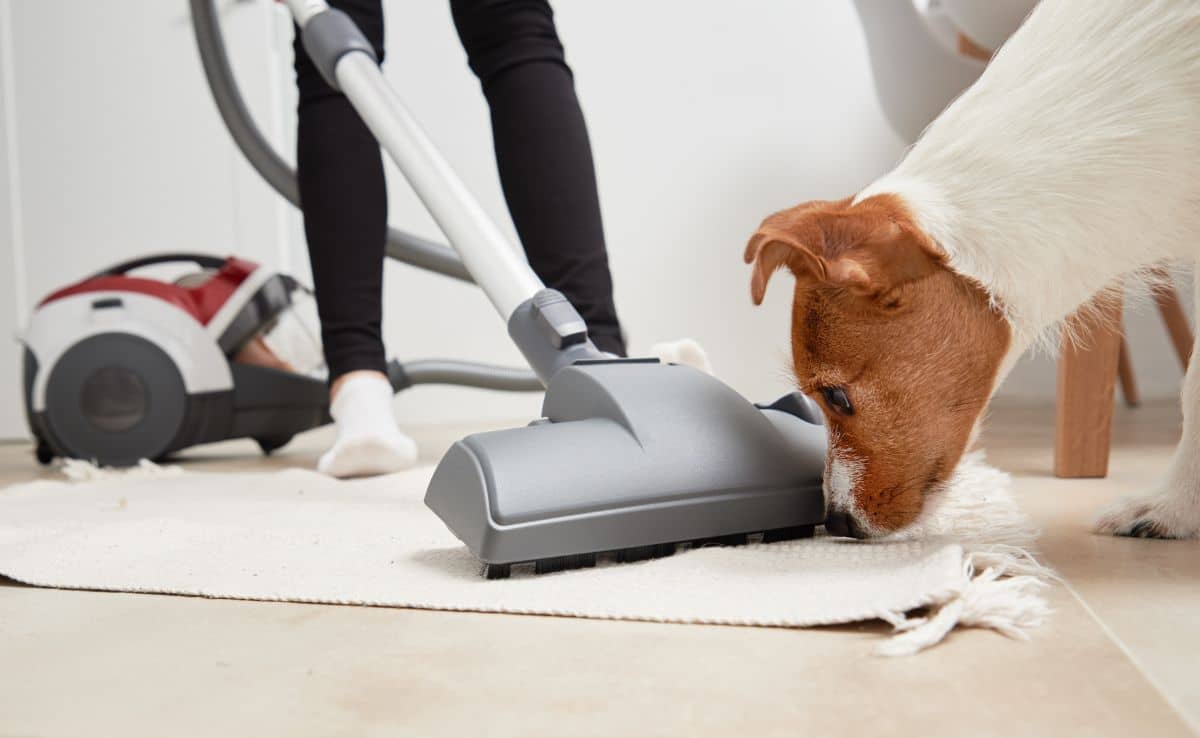
Vacuuming also lifts the fibers in your carpeting, which improves the penetration of insecticides down to the base of your carpet. To cover all your bases, be sure to vacuum under furniture and throw rugs, deep into cushions, and along your baseboards.
While research has shown that the vacuuming process kills flea eggs, etc., you may still want to empty your vacuum bag or canister in an outdoor trash can just to be on the safe side.
You’ll also need to wash linens, your bedding, and pet beds in the washing machine on the hot cycle. Mopping floors and steam cleaning carpeting can also get rid of flea eggs.
2. Flea Sprays and Home Treatments
Several home flea treatment products can also effectively kill eggs, larvae, and adult fleas.
Many people find sprays to be the easiest to use for all of their flooring and furniture. Here are some excellent options that get great reviews from pet parents:
- Adams Flea & Tick Home Spray
- Vet’s Best Flea & Tick Home Spray
- Wondercide Flea & Tick Sprays (for home & yard)
- Black Flag Flea & Tick Aerosol (for upholstery & pet bedding)
- PetArmor Home Carpet Powder For Fleas & Ticks
3. Steam Cleaning and Laundry Tips
Flea eggs are notoriously hard to kill, especially once they’ve fallen into carpet fibers, pet bedding, or upholstery. Regular vacuuming is helpful, but steam cleaning and high-heat laundering provide a powerful second line of defense.
Why Steam Cleaning Works
Steam cleaners use high temperatures that can penetrate deep into carpet and fabric layers, effectively killing:
- Flea eggs
- Larvae
- Pupae
- Adult fleas
Fleas cannot survive sustained exposure to heat above 100°F, and steam cleaners typically exceed 200°F.
Tip: Use a steamer on carpets, rugs, upholstered furniture, pet bedding, and baseboards. Focus on areas where your pet spends the most time.
Laundry Tips for Flea Control
Hot water and high heat are highly effective at killing flea eggs and larvae in bedding and fabrics.
Follow these steps:
- Strip and wash all pet bedding, blankets, and any fabric your pet lies on.
- Use the hottest water setting safe for the material.
- Dry items on the highest dryer setting for at least 30 minutes.
- Wash your pet’s toys or soft accessories if they’re washable.
Repeat weekly during an active infestation.
Optional Tip: Add white vinegar to the rinse cycle for added flea-repelling power (safe for pets, but test fabric first).
4. Repeat and Monitor: Flea Eggs Hatch in Cycles
Flea eggs don’t all hatch at once. A single treatment is rarely enough. Fleas develop in stages over several weeks, so consistent follow-up is essential.
Action Steps:
- Repeat vacuuming and laundering every few days during the initial 2–3 weeks.
- Reapply flea control sprays according to product directions.
- Use flea traps or dish-soap light traps to monitor activity.
- Continue inspection even after visible signs are gone to prevent re-infestation.
Key Takeaway
To truly get rid of flea eggs in your home, you must target every stage of the flea life cycle—repeatedly. Combining deep cleaning, high-heat laundry, safe flea control products, and consistent monitoring gives you the best chance at eliminating the problem for good.
Inspect Your Home for Fleas Before They Take Over
A hidden infestation can persist even after treating your pet. Inspecting your home thoroughly is crucial for catching flea hotspots and stopping the cycle.
Where to Look
Fleas and their eggs often hide in:
- Carpet fibers and area rugs
- Furniture, cushions, and seams
- Pet bedding and crates
- Cracks in hardwood floors or baseboards
- Behind or under furniture
- Vehicle seats if your pet travels with you
Signs of Flea Activity
- Tiny white or translucent oval specks (flea eggs)
- Black specks that resemble pepper (flea dirt)
- Flea larvae (wiggly, white, thread-like)
- Unusual itching or behavior in pets
- Bites on humans, especially around the ankles
DIY Inspection Tricks
- Wear white socks and walk slowly across carpeted areas; fleas may jump onto the fabric.
- Place a shallow bowl of water with dish soap near a nightlight overnight. Fleas are drawn to the light, jump, and drown.
- Use a flea comb on your pet and check for black specks or eggs on the comb and fur.
How To Inspect Your Home For Fleas (Video)
This two-minute video has some helpful tips on the best ways and places to look for fleas in your home.
4 Flea-Borne Illnesses: Why Fleas Are More Than a Nuisance
Fleas may seem like a minor annoyance, but they can transmit several dangerous diseases to both pets and humans.
According to the Centers for Disease Control and Prevention (CDC), fleas can transmit several harmful diseases to humans and animals through their bites or contaminated feces. These diseases include tapeworm infections, cat scratch disease, and, in rare cases, serious bacterial illnesses like murine typhus. Preventing flea infestations through consistent treatment of pets and household hygiene is essential to reduce the risk of these health threats.
1. Tapeworms (Dipylidium caninum)
Fleas can carry the larvae of tapeworms. When a dog or cat accidentally ingests an infected flea—often while grooming or biting at itchy areas- the tapeworm is released into their digestive tract.
How it spreads:
- Ingestion of infected fleas during self-grooming or scratching.
Symptoms in pets:
- Scooting or dragging their rear on the ground
- Weight loss despite normal appetite
- Visible rice-like segments in stool or near the anus
2. Cat Scratch Disease (Bartonella henselae)
Fleas transmit the Bartonella bacteria between cats through their bites and feces. Infected cats may show no symptoms but can pass the bacteria to humans through a scratch, bite, or lick on broken skin.
How it spreads:
- Fleas infect cats → cats scratch humans → humans contract the bacteria
Symptoms in humans:
- Swollen lymph nodes (especially near the site of the scratch)
- Fever, fatigue, and headache
- In rare cases, complications like eye infections or encephalitis
At-risk groups: Children and people with weakened immune systems are more vulnerable.
3. Flea Allergy Dermatitis (FAD)
Flea allergies are one of the most common medical consequences of flea exposure in pets. It’s not the flea bite itself that causes the problem, but a hypersensitive allergic reaction to proteins in flea saliva.

How it spreads:
- A single flea bite is enough to trigger a severe reaction in allergic pets.
Symptoms in pets:
- Intense, localized itching
- Red, inflamed, or oozing skin
- Hair loss from constant scratching or licking
- Increased risk of secondary skin infections
4. Murine Typhus (Rickettsia typhi)
This rare but serious bacterial infection is usually transmitted by fleas that have fed on infected rodents (such as rats or opossums). Fleas shed the bacteria in their feces, which can enter the human body through skin abrasions, mucous membranes, or flea bites.
How it spreads:
- Infected flea feces enter broken skin or are rubbed into the eyes or mouth
Symptoms in humans:
- Sudden high fever
- Headache and body aches
- Rash
- Nausea or vomiting
The Bottom Line
Fleas are more than an itchy nuisance. They are carriers of real diseases that can harm your pets and your family. Preventing flea infestations through regular treatment and maintaining good home hygiene is essential not only for comfort but also for health and safety.

Protect Your Dog Year-Round: Flea Prevention Starts Here
The most effective way to prevent a flea infestation is to stop it in its tracks. Most dogs benefit from monthly flea prevention, especially during warm seasons. You can use trusted options like the best flea collars for dogs or simplify the process with a convenient flea and tick subscription plan delivered right to your door. If you prefer a chemical-free route, these home remedies for fleas on dogs offer natural support to keep pests at bay.
Flea control is just one part of your dog’s overall parasite prevention. Heartworms, intestinal worms, and ticks are all threats that require year-round protection. You may even want to consider getting a pet wellness plan, which covers all of your pup’s preventative care, from annual exams to vaccines and much more.
Have You Battled Flea Eggs? Share Your Story Below
Flea eggs can turn a small problem into a full-blown infestation before you even know they’re there. If you’ve dealt with flea eggs on your dog, in your carpet, or around your home, we’d love to hear how you handled it. Share your experience in the comments; your story could help another pet parent win the battle against fleas!
